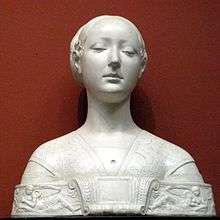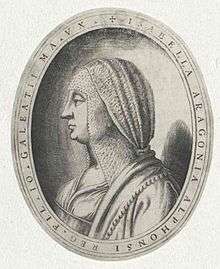Ippolita Maria Sforza
Ippolita Maria Sforza (18 April 1445 – 20 August 1488) was an Italian noblewoman, a member of the Sforza family which ruled the Duchy of Milan from 1450 until 1535. She was the first wife of Alfonso, Duke of Calabria, who later reigned as King Alfonso II of Naples.
| Ippolita Maria Sforza | |
|---|---|
| Duchess of Calabria | |
 Francesco Laurana, bust of a Princess of the House of Naples traditionally identified with Ippolita Maria Sforza | |
| Born | 18 April 1446 Cremona |
| Died | 20 August 1488 (aged 42) Naples |
| Spouse | Alfonso, Duke of Calabria |
| Issue | Ferdinand II of Naples Isabella of Aragon Piero, Prince of Rossano |
| House | House of Sforza |
| Father | Francesco I Sforza, Duke of Milan |
| Mother | Bianca Maria Visconti |
| Religion | Roman Catholic |
Family
Ippolita was born in Cremona on 18 April 1445, the eldest daughter of Francesco I Sforza, Duke of Milan, and Bianca Maria Visconti.[1] She had six brothers and one younger sister.
Her paternal grandparents were Muzio Sforza, a renowned condottiero, and Lucia di Torsano,[2] and her maternal grandparents were Filippo Maria Visconti, Duke of Milan and Agnese del Maino, daughter of Ambrogio del Maino, a Milanese nobleman and ducal questore.[3]
Early life and education
Ippolita was a very intelligent and cultured young woman. She was tutored by the Neoplatonic Greek scholar and grammarian Constantine Lascaris, who taught her philosophy and Greek. With her brothers she was taught in a palace school. When she was 14 years old she made a Latin address to pope Pius II at the diet of Mantua, which became well known after it was circulated in manuscript.[4]
She composed many letters. These have been published in Italy in a single volume entitled, The Letters of Ippolita Maria Sforza, and edited by Serena Castaldo. Previously, in 1893, in Bologna, F. Gabotto published a collection of Ippolita's letters which she had written in Naples from 1475 to 1482.[5]
Apart from epistolary activity, her notable writings include poetry and a Latin eulogy for her father Francesco.[4]
Marriage and issue

On 10 October 1465, in Milan, Ippolita, aged nineteen, married Alfonso, Duke of Calabria (4 November 1448 – 18 December 1495), the eldest son of King Ferdinand I of Naples and Isabella of Clermont, Duchess of Calabria.[6] He would later reign briefly as King Alfonso II of Naples. Ippolita was never crowned Queen consort as her death occurred ten years before Alfonso attained the Neapolitan throne. The marriage of Alfonso and Ippolita was politically advantageous as it created a powerful alliance between the Kingdom of Naples and the Duchy of Milan, which was one of the most important of the 15th-century Italian city-states. Ippolita was Alfonso's first wife. Her initially harmonious marriage descended into rivalry and contempt; her husband Alfonso, perhaps threatened by her high level of education or disdainful of her pedigree, treated her with a lack of respect throughout the marriage.[7]
Together, Alfonso and Ippolita had three children:
- King Ferdinand II of Naples (26 August 1469 – October 1496),[6] married Joanna of Naples (15 April 1479 – 27 August 1518)
- Isabella of Aragon, Duchess of Bari, Milan and Princess of Rossano (2 October 1470 – 11 February 1524), married her first cousin Gian Galeazzo Sforza, Duke of Milan[8]
- Piero, Prince of Rossano (31 March 1472 – 17 February 1491),[9] Lieutenant General of Apulia, died of an infection following leg surgery.
Ippolita Maria Sforza died at Naples on 20 August 1488 at the age of forty-three.[10]
In popular culture
Ippolita Sforza is played by Gaia Weiss in the Netflix series Medici.[11]
References
- Robin 2009, p. 390.
- Ippolito, Antonio Menniti (1998). "FRANCESCO I Sforza, duca di Milano". Dizionario Biografico degli Italiani (in Italian). 50.
- Catalano, Franco (1968). "BIANCA MARIA Visconti, duchessa di Milano". Dizionario Biografico degli Italiani (in Italian). 10.
- Stevenson 2005, p. 172.
- Covini 2006.
- Previté-Orton 1978, p. 767.
- Tribble 2012.
- Hollings 1911, p. 266.
- Bernuzzi 2003, p. 34.
- Duchess and Hostage in Renaissance Naples:Letters and Orations & Robin and Westwater 2017, p. 14.
- Medici (TV Series 2016– ) - IMDb, retrieved 30 June 2020
Sources
- Bernuzzi, Marco (2003). "Alfonso II of Aragon". In Bietenholz, Peter G.; Deutscher, Thomas Brian (eds.). Contemporaries of Erasmus: A Biographical Register of the Renaissance and Reformation. A–Z. University of Toronto Press.CS1 maint: ref=harv (link)
- Commire, Anne; Klezmer, Deborah, eds. (2000). Women in World History. Harr-I. Yorkin Publications.CS1 maint: ref=harv (link)
- Covini, Nadia (2006). Princesses and Ladies of Power at the Sforza Court.CS1 maint: ref=harv (link)
- Hollings, Mary Albright (1911). Europe in renaissance and reformation, 1453-1659. Macmillan.CS1 maint: ref=harv (link)
- Previté-Orton, C. W. (1978). The Shorter Cambridge Medieval History. Volume 2, The Twelfth Century to the Renaissance (9th ed.). Cambridge University Press.CS1 maint: ref=harv (link)
- Robin, Diana, ed. (2009). Francesco Filelfo: Odes. Harvard University Press.CS1 maint: ref=harv (link)
- Stevenson, Jane (2005). Women Latin poets: language, gender, and authority, from antiquity to the Eighteenth Century. Oxford University Press.CS1 maint: ref=harv (link)
- Tribble, Colin (2012). A Trusting Partnership: Sentiment and Politics in Quattrocento Dynastic Unions: Unpublished Dissertation. University of Edinburgh.CS1 maint: ref=harv (link)